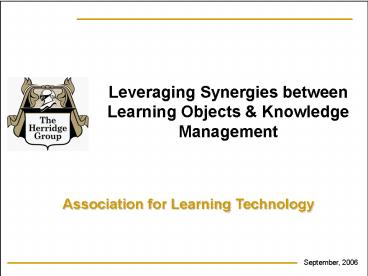Leveraging Synergies between Learning Objects - PowerPoint PPT Presentation
1 / 21
Title:
Leveraging Synergies between Learning Objects
Description:
Disseminating best practices to create optimum and consistence job performance. What is ... Focus is on converting individual knowledge into organizational ... – PowerPoint PPT presentation
Number of Views:35
Avg rating:3.0/5.0
Title: Leveraging Synergies between Learning Objects
1
Leveraging Synergies between Learning Objects
Knowledge Management
Association for Learning Technology
September, 2006
2
Learning Objects
Knowledge Management
3
- Both require
- Structured processes
- Support of web-enabled technologies
- Both focus on
- Disseminating best practices to create optimum
and consistence job performance.
4
What is Knowledge Management?
5
Knowledge Management
- Consists of
- Tacit
- Explicit
- Individual
- Structural, and
- Organizational Knowledge
- Business Imperative is to
- Identify the most critical knowledge, codified
it, managed it, and disseminated it to the people
who can make the most effective use of the
knowledge.
6
Knowledge Management
- Focus is on converting individual knowledge into
organizational knowledge by applying systematic
processes technology to - identify
- capture
- manage and
- disseminate the knowledge required to support
quick and decisive problem solving. - Challenge is to ensure performers can access the
knowledge they need, in a format that makes sense
to them. - Note knowledge is often captured and formatted
as best practices.
7
Knowledge Management
- Requires
- A robust database to store and manage the
knowledge assets - Web-enabled technology that supports
- Authoring
- Tagging
- Archiving
- Submission of knowledge assets to the database
- Searching, and retrieval of knowledge assets from
a performers work site.
8
Knowledge Management
- Four Main Aspects of Knowledge Management
- Collection of the best thoughts, practices and
wisdom - Use of a system (technology) that makes both
tacit and explicit knowledge readily accessible - Open and generous contribution to the knowledge
base by employees - An understanding on the part of Managers that
knowledge workers cannot and should not be
coerced into sharing their knowledge.
(Rossett, 1999)
9
Knowledge Management
- Supports
- Learning by providing access to information on an
as needed basis. - Development of a corporate vision and action by
pushing important information to targeted groups
of performers. - The corporate memory by being a storehouse of
intellectual capital. - Task accomplishment by providing productivity
tools. - Creativity by encouraging and supporting
collaboration and communities of practice. - Integration of knowledge between and across
groups allowing for greater leverage.
(Rosenberg, 2001)
10
What is a Learning Object?
11
Learning Objects
- A digital entity, deliverable over the internet
that is - A collection of assets covering a topic or
complex task as described by a terminal
objective. - A self-contained, context independent unit.
- Reusable and transportable.
- A meaningful division of learning that can be
accomplished in one sitting. - Made up of assets which are also reusable and
transportable.
12
(No Transcript)
13
Metadata Tags
14
Learning Objects Benefits
- Flexibility
- Ease of Updates, Searches and Content Management
- Customization
- Interoperability
- Increased value of Content
15
- Both Knowledge Management and Learning Object
initiatives - Support business goals and are oriented toward
performance presenting information in a
performance context - Require that employees be convinced to
participate - Create artifacts, be they knowledge assets or
learning objects - Rely on a repository (database), a tagging
schema, technology that facilitates management,
searching for, distribution, and display - Are more effective when templates, standards, and
processes are put in place to standardize and
prioritize contributions to the repository and, - Require a shift in corporate attitude from
restriction of access to information to rewarding
performers, groups, and departments for sharing
information.
16
- Both have been known to fail
- When not updated regularly with obsolete
artifacts removed. - When they are not integrated into normal working
practices - If the technology is to complicated or if
performers are not trained to use the technology
or, - If performers do not garner any personal or
professional benefit from contributing or
extracting from the repository.
17
- What Barriers Exist to Building on the Synergies
between Knowledge Management Learning Objects?
18
- Barriers
- Different backgrounds and language of the two
groups - The two initiatives are managed by different
functions with different funding, priorities, and
business directives - The two groups often use similar but different
methodologies and technologies.
19
Key Differentiator between Knowledge Management
Learning Objects Knowledge Management has a
social aspect as well as a management of
artifacts aspect. It is intended to facilitate
dialogue between performers, and to promote
action learning. communities of practice, and
problem solving.
20
- To reap the benefits organizations would need to
- Recognize that the end goals are to safeguard
intellectual capital and to promote superior and
innovative performance throughout the
organization - Place responsibility for the policy, budget, and
resources related to these goals under one locus
of control at the executive level (to ensure
sufficient influence) - Establish an implementation team comprised of key
skills from both the strategic business and
learning groups - Identify technical and procedural requirements
that meet the needs of both initiatives and
invest in a common technological infrastructure - Create and implement integrated processes,
procedures, standards and templates and, - Implement an approach to reward and recognition
that clearly demonstrates corporate commitment to
knowledge mining and sharing.
21
Thank You!
Joanne Mowat 416-694-2510 herridge_at_herridge.ca































